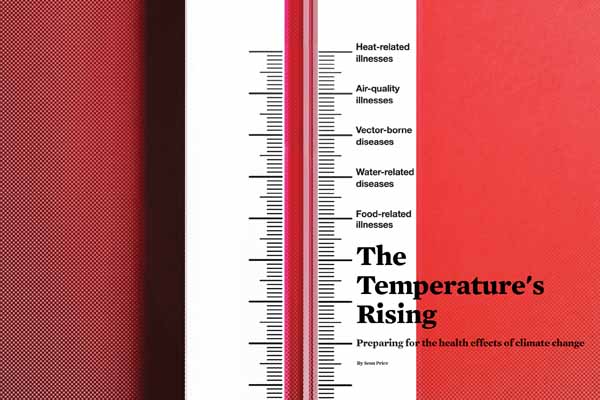
Robert Haley, MD, talks to audiences about climate change a lot as part of his work to reduce air pollution and ease the related lung ailments. When he does, the Dallas-area epidemiologist prefaces it with the understanding that not everyone is going to agree.
“There are very intense political feelings on both sides [of this issue], so it’s important to put those aside and, as we normally do in medicine, focus on what the evidence shows,” he said.
Even taking this approach, there are frequently intense discussions about how much or how little humans are responsible for a warming planet, says Dr. Haley.
And yet there are some aspects of climate change that everyone agrees on. For instance, 2019 registered as the second-warmest year – just behind 2016 – for global atmospheric heat in records dating back to 1850, according to a 2020 report by the World Meteorological Organization. And those high temperatures are part of a trend. (See “Texas’ Climate Forecast: Extreme,” page 23.)
This warming will have a concrete impact on public health, says the World Health Organization. It estimates that from 2030 to 2050, climate change will cause approximately 250,000 additional deaths per year worldwide from malnutrition, malaria, diarrhea, and heat stress alone.
And yet “the health effects of climate change aren’t looming off on the horizon,” said a Jan. 22, 2019, report in the Journal of the American Medical Association (JAMA). “They’re already here.”
In Texas, for instance, climate change has been blamed for contributing to the severity of several weather and health events, including the 2011 statewide drought, the 2012 outbreak of West Nile virus in Dallas, Hurricane Harvey in 2017, and the steadily increasing prevalence of vector-borne diseases like Zika and chikungunya.
However, climate change is complex and confusing in part because each of these events can be blamed on a confluence of trends, not just climate change, says Peter Hotez, MD, a professor of pediatrics and dean of the National School for Tropical Medicine at Baylor College of Medicine in Houston. Take the rise in vector-borne diseases, for instance.
“We can’t prove that it’s just from climate change because there are other things going on, like the shifting nature of poverty and urbanization,” he said.
However, climate is definitely a factor, he says.
“The consequences of global warming are warmer temperatures, higher average normal temperatures, and changes in rainfall patterns” – conditions that favor the spread of mosquitos and other vectors, he said.
Climate change not only spreads illnesses to places they had not previously occurred, it also can deepen existing problems, such as respiratory and heat-related illnesses, says Ray Fowler, MD, an emergency physician at Parkland Hospital in Dallas. Physicians and public health officials need to prepare for the numerous impacts of climate change just as they would for a pandemic like COVID-19. That will require understanding how climate change is likely to impact their region and plan accordingly. (See “Resources,” page 23.)
“I hope that we can agree that we as a population must identify the risks to health that occur from climate change and can continue to take the measures necessary to improve public health,” Dr. Fowler said.
Here are some of the most important climate-related health problems Texas physicians can expect according to climate scientists and the physician experts Texas Medicine spoke to.
Heat-related illnesses
Rising heat will hit Texas and the rest of the U.S. in two ways: An increase in average temperatures and a rise in the number of 100°F days in the summer, according to the U.S. Global Change Research Program (USGCRP), a federal project that researches environment issues for client U.S. agencies, including the National Science Foundation.
“Some of the expected things are more heat-related illness, more heat waves, more heat strokes, more heat exhaustion,” Dr. Haley said.
These illnesses tend to affect the very old and very young, the USGCRP report says. They’re also likely to lead to more occupational illnesses and deaths among people who have to work outdoors.
Heat-related deaths are difficult to measure because they’re frequently chalked up to cardiac causes without mentioning temperature as the underlying factor, according to an Oct.15, 2014, JAMA report.
Air conditioning does help save lives, the JAMA article states. However, heat waves in the Midwest and Europe in recent years show that intense, prolonged heat can kill thousands of people in a brief period.
Air-quality illnesses
A warmer world is a dryer world, and a dryer world will have more gunk in the air to make people sick, Dr. Fowler says.
“The second-most common type of illness in the pediatric universe is respiratory-type illness,” he said.
Increased carbon in the air stimulates plant growth, which in turn throws more pollen into the air, exacerbating allergies and asthma, he says. Hot, dry days also are the worst for ozone pollution, and – like so much with climate change – this causes a domino effect, says Dr. Haley, who helped lead the fight against ozone-producing power plants in the Dallas area. (See “Fighting Epidemics: Robert Haley, MD, Wins the Nickey Award for Public Health,” March 2020 Texas Medicine or www.texmed.org/NickeyAward2020.)
“Numerous studies show that when the daily ozone level goes up, in the succeeding four or five days we see a rise in mortality due to asthma, [chronic obstructive pulmonary disease], and heart attacks,” he said. “The higher [the ozone level], the more these go up.”
Finally, heat increases the risk of wildfires, which in turn damages air quality. Australia’s unprecedented wildfires in December and January produced enough particulate matter to make the air dangerous to breathe in several major cities.
Texas saw similar air-quality problems during the wildfires that came with the 2011 drought. March 2011 was the driest March since records began in 1895, according to the Texas A&M Forest Service. And the wildfires generated smoke that clouded areas dozens of miles away. Those problems will worsen in a dryer, hotter climate, Dr. Haley says.

Vector-borne diseases
Vectors thrive in warm weather, so a warming world is likely to have more vector-borne illnesses, Dr. Hotez says.
“Of particular relevance and concern are the warming effects conducive to insect vector expansion and transmission, which could alter current mosquito, sandfly, flea, and kissing bug distributions,” he stated in a 2018 study on the rise of neglected tropical diseases in Texas (tma.tips/TropicalStudy).
This expansion is likely to increase the prevalence of several vector-borne diseases, including dengue, chikungunya, Zika, and murine typhus.
But vector-borne illnesses can be difficult to predict, even when conditions for them seem perfect, Dr. Haley says. Disease outbreaks tend to occur when several unusual events coincide, such as when an unusually warm winter coincides with a mosquito population carrying West Nile virus. And they will coincide more often as warm winters become more common, he explains.
It may be hard to tell if vector-borne illnesses are growing because current diagnosis and surveillance remains weak, Dr. Hotez says in his 2018 paper. For instance, the U.S. Centers for Disease Control and Prevention estimates that less than 1% of Chagas cases are diagnosed in Texas. However, the Texas Department of State Health Services recently received funding to improve that surveillance, he says.
Texas has uneven vector eradication efforts, Dr. Haley adds. Some large counties like Harris and Dallas are good at it; others have little or no funding for it. If temperatures keep rising and vectors continue to proliferate, even the large counties may find it hard to keep up, he says.
“At some point, the vector threats will overpower our vector-eradication efforts,” he said.
Water-related diseases and other problems
Just about everything about climate change is bad for water quality, Dr. Haley says.
“Heat and flooding or droughts – all of those tend to cause failures of water systems,” he said.
Heat and drought can crack water pipes; flooding can overwhelm local water systems and cause sewage overflow. That’s especially true in areas with aging infrastructure, according to the USGCRP report. This heightens the risk that “water-related pathogens, chemicals, and algal toxins will increase in recreational and shellfish harvesting waters and in drinking water,” the USGCRP says.
A warmer climate also will bring toxin-producing algal blooms in sea water, which can harm both people and wildlife, USGCRP says.
More importantly, climate change is altering the chemical balance of the oceans, causing them to become more acidic, Dr. Haley says, a phenomenon that has hit Gulf Coast areas particularly hard.
“There’s increasing heat and [greater acidity], and both of those are conspiring to change the habitat of sea life,” Dr. Haley said. “The increased acidity is eroding the shells of oysters and other creatures that we use as food. And as the temperature warms, fish relocate their habitat further north to maintain the habitat for which they evolved.”
This will cut off or diminish a major source of food for all Texans, especially those who live along the Gulf Coast, Dr. Haley says.
Other food-related illnesses and problems
There’s a good news-bad news picture for climate change’s impact on food from crops, Dr. Haley says. The good news is that the CO2 that builds up in the air from cars and smokestacks tends to make plants – and their fruits – grow better and faster. The bad news is that their protein and essential mineral content tends to be lower. People eating less-nutritious foods are less likely to be healthy and more prone to disease, he says.
That problem will likely be outweighed by the fact that many crops will be more difficult to grow, causing food shortages. Farmers rely on dependable weather patterns to tell them what crops can grow, the USGCRP report says. But climate change throws a wrench in their plans. It produces rising temperatures and more extreme weather events. Rain falls at the wrong times and won’t fall where it should.
Texas farms will have increasing problems growing traditional crops as temperatures increase and rainfall becomes more erratic, Dr. Haley says, adding that farmers in Central America already are facing this problem, and it has forced many farms to shut down.
Texas’ Climate Forecast: Extreme
There’s an old saying that if you don’t like the weather in Texas, wait five minutes. So what’s the long-term climate forecast for the state? Kind of like the old saying, only more so, according to a 2020 report from the Office of the Texas State Climatologist at Texas A&M University.
For instance, the report found that extreme rainfall has become more frequent and severe, and is expected to get worse. That means the number of fast, heavy rainfalls will probably rise by 2-3% by 2036, the report says. As a result, there will be a significant increase in urban flooding – as much as 15% more than occurred between 2000 and 2018.
Despite this, increased temperatures and other factors are likely to make drought spread and become more severe.
“Overall, increased dryness should extend the wildfire season in places where the fire season is presently constrained by low levels of aridity, such as eastern Texas,” the report said.
Not surprisingly, temperatures will rise.
“The number of 100-degree days at typical stations is expected to nearly double by 2036 compared to 2000- 2018, with a typical year having 25 triple-digit days at urban and rural stations and 20 triple-digit days at semi-urban stations,” the report said.
While tornadoes and thunderstorms are hard to predict, the warmer temperatures are likely to result in an “overall increase in the number of days capable of producing severe thunderstorms.” Meanwhile, sea levels will rise, doubling the risk of storm surges along the Gulf Coast.
Tex Med. 2020;116(5):18-23
May 2020 Texas Medicine Contents
Texas Medicine Main Page